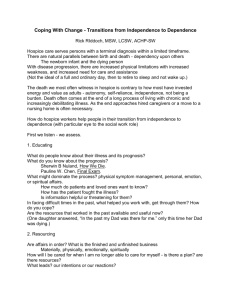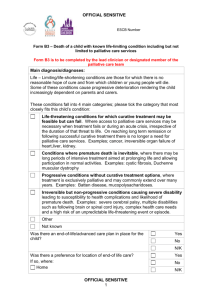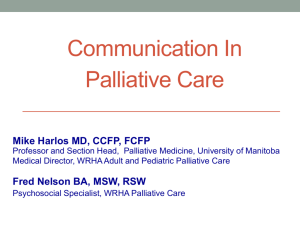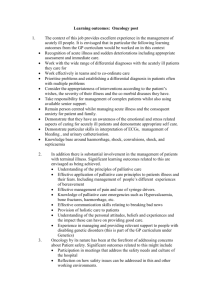Integrating Palliative Care into your Primary Nursing Practice Susan DeSanto-Madeya, PhD, RN
advertisement
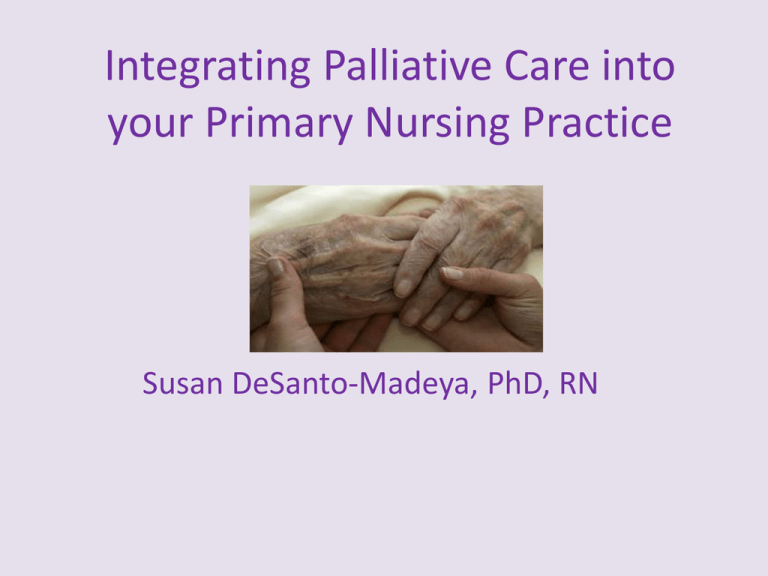
Integrating Palliative Care into your Primary Nursing Practice Susan DeSanto-Madeya, PhD, RN DISCLOSURES None of the planners or presenters of this session have disclosed any conflict or commercial interest Integrating Palliative Care into your Primary Nursing Practice OBJECTIVES: 1. Describe the philosophy and principles of palliative and end-of-life care 2. Describe the physical, psychological, social and spiritual issues of individuals and families living with serious and life-limiting illnesses 3. Identify opportunities to incorporate palliative care into your advanced nursing practice setting to meet the physical, psycho-social, and spiritual needs of individuals and families living with serious illness. “You matter because you are you. You matter until the last moment of your life, and we will do all we can , not only to help you die peacefully but to live until you die.” Dame Cicely Saunders Founder of St. Christopher’s Hospice London, England Palliative Care “An approach that improves the quality of life of patients and their families facing the problems associated with life-threatening illness, through the prevention and relief of suffering by means of early identification and impeccable assessment and treatment of pain and other problems physical, psychosocial and spiritual.” WHO, 2008 Palliative Care • Individuals and their families struggling to live in the face of progressive, symptomatic and debilitating disease, can be well-cared for and supported throughout this process and find meaning and peace in the face of death • Essence of palliative care nursing is to facilitate the “caring” process through science, presence, openness, compassion, mindful attention to detail, and teamwork Hospice Care • Modern hospice movement started in 1967 to address the needs of the dying and their families • “Hospice” – designate way-stations for Pilgrims on their way to the Holy Land • Dame Cicely Saunders viewed life as a journey … those near the end of life’s journey needed support to complete the passage • 1970s Florence Wald created the 1st American Hospice Hospice Care • Based on the idea that dying is part of the normal life cycle • No longer receive life-prolonging or curative therapy • Life expectancy (< 6 months) • Require comprehensive medical, psychosocial, and spiritual support as they enter the terminal stage of an illness Shifting the Paradigm of End-of-Life Care to Palliative Care • Advances in healthcare have changed the trajectory of dying: early detection and treatment of disease ability to prolong life fewer deaths from chronic illnesses • In the US, more than 70% of those who die each year are 65 years of age or older • The majority of these deaths occur after long, progressively debilitating chronic illness Options for ….. • Patients living with chronic, debilitating disease, whose life expectancy was >6 months • Continued to seek life-prolonging or “curative” treatment • Did not want to be “identified” as a hospice patient (dying patient) Palliative Care • A philosophy of care - an organized, interdisciplinary system for delivering care • Goal: improve the quality of life for patients with life threatening illness and their families through prevention and relief from suffering • Identification, assessment, and treatment of pain and physical, psychosocial, and spiritual problems Palliative Care • Appropriate at any stage of the disease or need for other therapies • Can be provided with life-prolonging treatment or as main focus of care • Expands traditional disease-modeled medical treatment to include: – the goals of enhancing QOL for patients and families – helping with decision-making – providing opportunities for personal growth and finding meaning Relationship between Hospice and Palliative Care • Front loading of Palliative Care - at time of diagnosis and treatment, access to services • Change standard of care “too little, too late” • Hospice is a program where palliative care is intensified as an individual moves closer to death • Transition seamlessly and without added distress from Palliative Care Hospice Care Palliative Care: Continuum of care Death Disease-Modifying Treatment Hospice Care Palliative Care Bereavement Support Terminal Phase of Illness NQF, 2006 Barriers to Palliative Care • Failure to acknowledge limits of medicine • Guilt “unable to cure” • Lack of experience with death and dying/ experiencing personal grief issues • Limited understanding of hospice and palliative care services • Issues regarding pain control and symptom management, regulation of controlled substances, access to care, and insurance coverage • Denial of death / fear of own mortality Palliative Care Approach • Patients and families experience illness and the last phase of life as multi-dimensional human beings • Creating a personalized experience with each patient and family with a focus on opportunities to find meaning and personal growth in the midst of a very difficult time • Promoting quality of life and relationships, as well as death with dignity, and assisting patients and families live each day as fully as possible Physical Psychological Functional Ability Strength/Fatigue Sleep & Rest Nausea Appetite Constipation Pain Anxiety Depression Enjoyment/Leisure Pain Distress Happiness Fear Cognition/Attention Quality of Life Social Spiritual Financial Burden Caregiver Burden Roles and Relationships Affection/Sexual Function Appearance Hope Suffering Meaning of Pain Religiosity Transcendence Illness, Caregiving, Dying, and Bereavement • Respecting individuality • Confronting the fullness of the human context in which illness occurs • How one adapts to changes brought on by illness is personal • What one person defines as quality of life may differ drastically from the next person or differs at points in the life continuum Knowing Dimensions of the Patient’s and Family’s Experience Mrs. D. has increasing levels of fatigue and shortness of breath (physical dimension). She can no longer walk from her bedroom to the kitchen and is becoming more isolated and dependent (physical and social dimension). Mrs. D. is showing signs of depression and withdrawal (psychosocial dimension). She prays for God to take her, yet in the same prayers, asks for his forgiveness (spiritual dimension). Knowing Dimensions of the Patient’s and Family’s Experience Mr. D. is awakened many times during the night to assist Mrs. D. and is becoming exhausted and often falls asleep in the chair during the daytime (physical dimension). Mr. D. is no longer able to keep up with Mrs. D.’s care, the laundry, housecleaning, and cooking ( physical/functional dimension). Afraid to leave Mrs. D. alone, he no longer visits with his friends at the diner (social dimension). He prays with Mrs. D., asking for strength and praying that she will live as he does not know what he will do with out her (spiritual dimension). Knowing Dimensions of the Patient’s and Family’s Experience • The interactions of all dimensions of the experience need to be assessed • Provide resources, assistance, and support to find meaning in the caregiver/care receiver relationship • This experience holds an opportunity to determine what matters most, influence the outcome for improved quality of life closure, uncovering new and deeper sources of meaning in people’s lives Enhancing Quality of Life Closures A patient with CPOD was becoming progressively anxious with increased shortness of breath, despite medical interventions. On further assessment, the patient shared that he had a son, he had not spoken to in years. The patient was afraid of dying before mending that relationship, apologizing to his son, and letting him know he loved him. The son was located. The patient and son were able to spend time together, give and receive love and forgiveness. The unfinished relationship issues were the cause of his physical shortness of breath. Honoring the Experience • Support the patient and family as the unit of care • Patients – burden they may cause their family and how their family will survive after they are gone • Family - how to care for the patient, how their lives will change after the death • Adaptation to role changes, relationship changes, life changes, reactions to losses Honoring the Experience • Responding to patients’ and families’ suffering • Providing suggestions for interacting, communicating with each other, touching, completing relationships, celebrating shared lives, and goodbye • Care does not stop after the patient’s death. Families can receive hospice bereavement education and support for a minimum of 1 year following their loved one’s death Care Directed by Patient and Family Choices and Values • Ongoing facilitated conversations with the patient and family to discern what is most important to them – values, choices, wishes, and needs for their life and death • Goals become patient and family goals rather than nurse practitioner directed goals Care Directed by Patient and Family Choices and Values • Worries, fears, and hopes become paramount, it is vital to open the dialogue as soon as possible • Patients’ and families’ questions can be answered, options and choices for dealing with their concerns can be offered • Emotional and spiritual support from the time of diagnosis, including preparation for remaining life, advancing illness, caregiving, preparation for family, death, and bereavement creates optimal experiences Care Directed by Patient and Family Choices and Values • Anticipation and prevention of negative effects of physical symptoms, suffering can be decreased – allows for patient and family time and personal resource energy to attend to their living • Promote personal growth, deepening or reconnecting personal and spiritual relationships, and preparation for death and afterlife with enrichment of meaning Care Directed by Patient and Family Choices and Values • Greatest concern for patients and families is the fear of loss of control • Anticipated losses: – Bodily function – Independence and self-care – Income with resulting financial burdens – Ability to provide for loved ones – Time to complete tasks and mend relationships – Decision-making capacity Care Directed by Patient and Family Choices and Values • Provide continued opportunities for choice, input, informed decision-making, and the ability to change decisions as the situation changes (illness progresses). Care Directed by Patient and Family Choices and Values • Best medical treatment to improve function • Never having to endure overwhelming pain, shortness of breath, other symptoms • Care that is continuous, comprehensive, and coordinated • Being prepared for everything that is likely to happen in the course of their illness • Having their wishes sought, respected, and followed • Having the opportunity to make the best of everyday Informed Decisions and Autonomy • Open, trusting relationships • A sense of knowing relieves the burden of the unknown • Knowing and talking about the diagnosis and prognosis aids in making informed decisions • Empowering patients and families to make their own decisions regarding life and death • Discussion of goals of care and advance directives • Educate on issues and support • Encourage and allow choices to change Dignity and Respect • Maintain lifestyle choices and respect their philosophy of life: ethnicity, culture, social and sexual preferences, varied family structure • Accept patient and families “where they are” approaching living and dying in their own way • Encourage to express emotions: anger, denial, depression “ My wife has been diagnosed with a disease but it’s the devastation of that disease that we live each day…. Bearing witness to illness is one thing. Bearing witness to pain is quite an other. I feel I am becoming the patient on many levels. I, too, cannot sleep. I am anxious and depressed and tearful. I am attempting to be provider, spouse, father and mother. As I measure medication I shudder at the reality that I am pouring a dose of morphine for my wife. There is something surreal about this way of being that now fills my daily life. I am not the patient. I am the witness.” ( Ferrell,B 2005) To be invited to be present with a patient and family at the end of life is a privilege and honor. A peaceful and respectful death, free of pain and suffering, is a wonderful gift to patients and their families. Family members will replay those last moments of life with their loved one for the rest of their lives.

